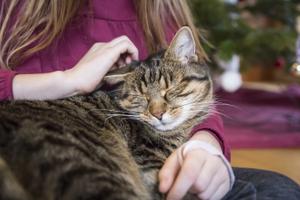

Studien haben gezeigt, dass Haarlänge und -farbe keinen Einfluss auf die Produktion von Fel d 1 haben, aber es gibt einen physischen Faktor, der damit zu korrelieren scheint: das Geschlecht der Katze.1-6
Die Fakten
Einige Studien haben ergeben, dass das Geschlecht der Katze mit der Produktion von Fel d 1 korreliert.
- Es wurde nachgewiesen, dass nicht kastrierte Kater mehr Fel d 1 produzieren als sterilisierte/kastrierte Kater und weibliche Katzen, unabhängig von ihrem Sterilisierungsstatus.1, 6-9
- Allerdings variiert der Fel d 1-Wert je nach Genetik, und ein nicht kastrierter Kater kann potenziell weniger Fel d 1 produzieren als eine weibliche Katze oder ein sterilisierter Kater mit hoher Produktion.1,6,8-11
Weitere Informationen
- Kelly, S.M., Karsh, J., Marcelo, J., Boeckh, D., Stepner, N., Litt, D.,...Yang, W.H. (2018). Fel d 1 and Fel d4 levels in cat fur, saliva and urine. Journal of Allergy and Clinical Immunology. doi: 10.1016/j.jaci.2018.07.033
- Bonnett, B., Messaoudi, K., Jacomet, F., Michaud, E. Fauquert, J.L., Caillaud, D., & Evrard, B. (2018). An update on molecular cat allergens: Fel d 1 and what else? Chapter 1: Fel d 1, the major cat allergen. Allergy, Asthma and Clinical Immunology, 14, 14. doi: 10.1186/s13223-018-0239-8
- Butt, A., Rashid, D. & Lockey, R. (2012). Do hypoallergenic cats and dogs exist? Annals of Allergy Asthma and Immunology, 108, 74-76.Fel D 1
- Nicholas, C., Wegienka, G. & Havstad, S. (2008). Influence of cat characteristics on Fel d 1 levels in homes. Annals of Allergy Asthma and Immunology, 101, 47-50
- Siebers, R., Healy, B., Holt, S., Peters, S., Crane, J. & Fitzharris, P. (2001). Fel d 1 levels in domestic living rooms are not related to cat color or hair length. Journal of Allergy and Clinical Immunology, 108, 652-653. doi: 10.1067/mai.2001.118788
- Platts-Mills, T.A.E., Vervloet, D., Thomas, W.R., Aalberse, R.C. & Chapman, M.D. (1997). Indoor allergens and asthma: report of the Third International Workshop. Journal of Allergy and Clinical Immunology, 100, S2-S24. doi: 10.1016/S0091-6749(97)70292-6
- Zielonka, T., Charpin, D., Berbis, P., Luciani, P., Cassanova, D. & Vervloet, D. (1994). Effects of castration and testosterone on Fel d 1 production by sebaceous glands of male cats: I. Immunological assessment. Clinical and Experimental Allergy, 24, 1169-1173
- Ramadour, M., Birbnaum, J., Magalon, C., Lanteaume, A., Charpin, D. & Vervloet, D. (1998). Cat sex differences in major allergen production (Fel d 1). Journal of Allergy and Clinical Immunology, 10, 282-284.
- Jalil-Colome, J., de Andrade, A.D., Birnbaum, J., Casanova, D., Mege, J.-L., Lanteaume, A., Charpin, D., & Vervloet, D. (1996). Sex difference in Fel d 1 allergen production. Journal of Allergy and Clinical Immunology, 98(1), 165-168.
- Morgenstern, J.P., Griffith, I.J., Brauer, A.W., Rogers, B.L., Bond, J.F., Chapman, M.D. & Kuo, M.C. (1991). Amino acid sequence of Fel dI, the major allergen of the domestic cat: protein sequence analysis and cDNA cloning. Proceedings of the National Academy of Sciences, 88, 9690-9694.
- Bastien, B., Gardner, C. & Satyaraj, E. (2019). Influence of phenotype on salivary Fel d 1 in domestic shorthair cats. Accepted, Journal of Feline Medicine and Surgery.